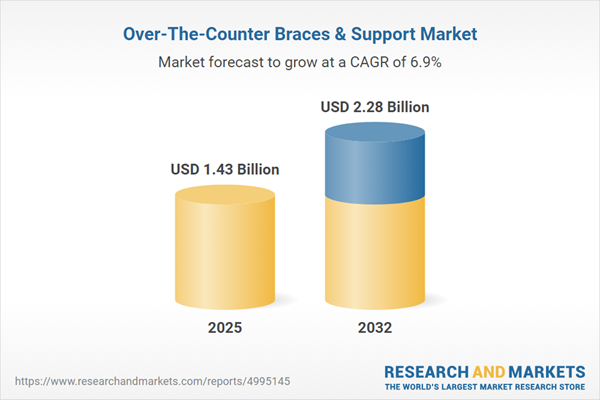Speak directly to the analyst to clarify any post sales queries you may have.
Senior decision-makers navigate a complex over-the-counter braces and support market shaped by rapid innovation, shifting consumer needs, and evolving regulations. Maintaining competitiveness requires an integrated approach to development, implementation, and risk management.
Market Snapshot: Over-the-Counter Braces & Support Market
The over-the-counter braces and support market is experiencing steady growth, with global revenues advancing significantly over the forecast period. Expansion is fueled by rising musculoskeletal health concerns and a greater emphasis on preventative care, especially across aging and active populations. Industry frontrunners remain focused on delivering evidence-based solutions, prioritizing comfort, flexibility, and clinical outcomes. This evolution benefits a range of users, from home-based individuals to clinical professionals, as demand grows for adaptable and effective support in both medical facilities and everyday routines.
Scope & Segmentation of the Over-the-Counter Braces and Support Market
Decision-makers receive detailed insights that sharpen strategy, allocate resources efficiently, and clarify where emerging opportunities lie within the over-the-counter braces and support market. The following segmentation reflects critical factors influencing growth, regional dynamics, and technology adoption:
- Product Types: Covers braces and supports for ankle, knee, back, elbow, wrist, and shoulder, addressing needs for improved mobility, joint stability, and rehabilitation support in various use cases.
- Material Types: Ranges from cotton, neoprene, and metal to advanced polymers, designed to offer lasting comfort, enhanced durability, and reliable clinical performance.
- Distribution Channels: Includes online marketplaces, retail outlets, pharmacies, specialized health stores, and drugstores, supporting seamless access for healthcare professionals and consumers.
- Applications: Encompasses post-surgical recovery, day-to-day support, sports injury care, occupational health, and preventative scenarios, broadening utility across user segments.
- End Users: Targets both private consumers at home and clinicians working in hospitals, outpatient centers, and long-term care facilities, aligning with trends in self-care and institutional care delivery.
- Regional Markets: Spans the Americas, Europe, Middle East, Africa, and Asia-Pacific, with tailored strategies to address variations in regulation, reimbursement, and market access within each geography.
- Key Technologies & Innovations: Features integration of breathable fabrics for improved comfort, embedded sensors for data insights, additive manufacturing for customizable fits, adaptive polymers for flexibility, and digital fitting tools supporting telehealth and remote consultations.
- Company Coverage: Profiles major vendors such as DJO Global, Össur hf., BSN Medical, 3M, DeRoyal Industries, Bauerfeind, Medi GmbH & Co. KG, Breg, Mueller Sports Medicine, and Thuasne SA, analyzing competitive positioning and innovative strategies in the sector.
Key Takeaways for Senior Decision-Makers
- Align product portfolios and go-to-market approaches with changing demographics and increasing demand for preventative health solutions to identify untapped market opportunities.
- Leverage advancements in materials to improve device comfort, usability, and adherence, facilitating better outcomes for both clinician and consumer stakeholders.
- Utilize digital tools and diversify distribution channels to increase engagement with healthcare systems and retail networks, supporting flexible sales and customer service models.
- Diversify offerings to address home- and sports-focused needs, ensuring relevance for evolving user preferences and expanding overall market reach.
- Foster partnerships with providers and expand direct-to-customer channels to heighten responsiveness and adapt quickly to new care delivery models.
- Implement robust, data-driven processes for regulatory compliance, mitigating operational risks and enabling strategic agility during policy shifts.
Tariff Impact and Supply Chain Adaptation
Revised tariffs in the United States have added new complexity to supply chain operations within this sector. Organizations have responded by broadening their supplier networks, optimizing logistics processes, and strengthening relationships with domestic partners. Industry collaboration and adaptive procurement practices help maintain product availability and value as the market responds to shifting trade conditions.
Methodology & Data Sources
This report’s analysis draws from executive interviews, regulatory landscape studies, and systematic patent reviews. Each conclusion undergoes independent validation to deliver findings that are practical, credible, and directly relevant to industry leadership decisions.
Why This Report Matters
- Provides granular regional and end-user analysis that supports strategic focus in high-opportunity segments and efficient resource allocation.
- Guides leaders through the digital transition and regulatory landscape, enabling alignment with current best practices and shifting industry standards.
- Offers recommendations to reinforce supply chain resilience, reduce logistical risks, and sustain business continuity amid evolving external challenges.
Conclusion
By applying these strategic insights, senior leaders can address shifting demands and market complexities, maintaining organizational resilience and advancing within the dynamic over-the-counter braces and support market.
Additional Product Information:
- Purchase of this report includes 1 year online access with quarterly updates.
- This report can be updated on request. Please contact our Customer Experience team using the Ask a Question widget on our website.
Table of Contents
3. Executive Summary
4. Market Overview
7. Cumulative Impact of Artificial Intelligence 2025
Companies Mentioned
The companies profiled in this Over-The-Counter Braces & Support market report include:- DJO Global, Inc.
- Össur hf.
- BSN Medical GmbH
- 3M Company
- DeRoyal Industries, Inc.
- Bauerfeind AG
- Medi GmbH & Co. KG
- Breg, Inc.
- Mueller Sports Medicine, Inc.
- Thuasne SA
Table Information
| Report Attribute | Details |
|---|---|
| No. of Pages | 185 |
| Published | November 2025 |
| Forecast Period | 2025 - 2032 |
| Estimated Market Value ( USD | $ 1.43 Billion |
| Forecasted Market Value ( USD | $ 2.28 Billion |
| Compound Annual Growth Rate | 6.9% |
| Regions Covered | Global |
| No. of Companies Mentioned | 11 |









